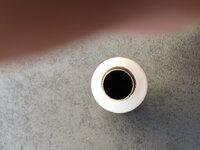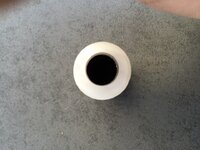Warren White
Member
I think I might know the problem (which probably exists between my own ears).
The issue is that when I was drilling some acrylic on my lathe, I heard more noise than I was used to. I thought it might be that the acrylic was a bit harder than it had been in the past.
Well, the outcome wasn't pretty. As you can see in the photos, the entry hole is fairly good. The exit hole is much larger than it should be.
I think I may have neglected to tighten the tailstock quill lock handle. Does this sound like a reasonable reason for the result I am seeing? Any other suggestions? The bad thing is that I drilled a number of blanks, painted the inside, waited a few days and then epoxied the tubes in. As a result, I have three pens and two perfume holders that are a bit messed up.
I will let you know how this turns out, but in the meantime, could I be on the right track?
Thanks,
Warren (the perplexed and unhappy)
The issue is that when I was drilling some acrylic on my lathe, I heard more noise than I was used to. I thought it might be that the acrylic was a bit harder than it had been in the past.
Well, the outcome wasn't pretty. As you can see in the photos, the entry hole is fairly good. The exit hole is much larger than it should be.
I think I may have neglected to tighten the tailstock quill lock handle. Does this sound like a reasonable reason for the result I am seeing? Any other suggestions? The bad thing is that I drilled a number of blanks, painted the inside, waited a few days and then epoxied the tubes in. As a result, I have three pens and two perfume holders that are a bit messed up.
I will let you know how this turns out, but in the meantime, could I be on the right track?
Thanks,
Warren (the perplexed and unhappy)


